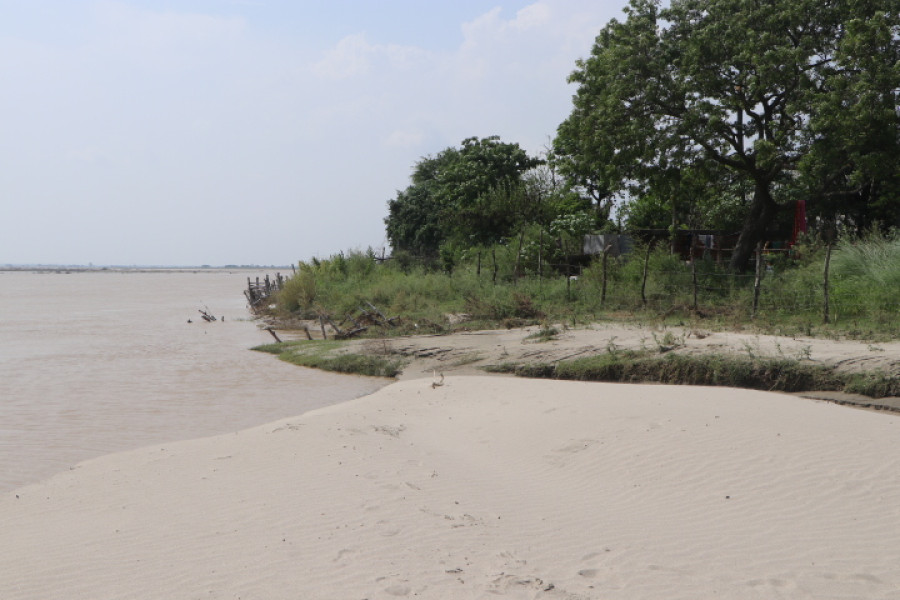Lumbini Province
After Covid-19, Narainapur locals have another fear to grapple with: flood
Narainapur might have dodged the worst effects of Covid-19 but as the rainy season sets in, the fear of a flood haunts villagers.
Madhu Shahi & Rupa Gahatraj
At about 2pm on Tuesday, Najiya Nuri is hard at work in her kitchen as dense clouds swirl overhead. She has to be quick to prepare lunch for if it rains, the roof will leak and kill the fire in the mud oven. If the rain continues for hours, the currents of the Rapti River will enter her house at Bhagwanpur in Narainapur Rural Municipality. On Saturday, it did after an incessant rain that lasted for hours.
“We have to eat our meals well before it rains regardless of whether it’s properly cooked or not,” Najiya, who is 16, said. She starts cooking after observing the movement of the clouds, she added.
In mid-May, Narainapur made national headlines as the village turned into a hotspot of the Covid-19 crisis in the country where one person died and dozens from a single quarantine facility were diagnosed with the virus. The situation worsened as the village didn’t have a hospital with even the most basic facilities and locals protested against taking their infected relatives elsewhere. By the first week of June, the situation was more or less under control, as the infected individuals were transferred to isolation facilities in Nepalgunj and Kohalpur.
But a month after the crisis, the woes of Narainapur locals are far from over. While they are reeling under one crisis, there’s another looming: the perennial flood. These days the villagers plan their day around the movement of the rain clouds so as to make a quick escape in case of a flood.
On Saturday, when the rain entered their home, Najiya’s family of nine stayed awake all night fearing a possible flood. This is what they have been doing every rainy season. Earlier, the locals had come together to create an embankment to prevent the river from running off its course, but the makeshift barrier hasn’t stopped the mighty currents. To prevent possible floods from entering the settlements, Narainapur needs an embankment of at least 200 metres, but the existing one is only 25 metres long, locals say. As a result, the river has reached the homes of almost everyone in ward number 6.
According to Birendra Pal, chair of ward no. 6, Gangapur, Jamuni, Kohala, Lakshmanpur and Rampur Joljala are the villages that are at high risk of getting inundated by floods in the Rapti River. Over 1,600 families will be directly affected by floods in the river, Pal said. The flood of 2016 had permanently displaced as many as 200 families in the local unit.
“Despite the perennial damage that the flood causes, there are no places for the locals to take shelter in,” Pal said. After thousands of acres of arable land and scores of houses were deluged in the 2016 floods, many youths were compelled to migrate to India for work. Many have returned following the coronavirus crisis but they don’t have any land to generate income from, Pal said.
The risk of a flood in Narainapur is high and there are signs that the flood may turn violent this year, said Gauri Budhathoki, information officer at the District Emergency Work Operation Centre. On Saturday, police rescued 11 people from the Rapti River. The river’s surface had risen to 5m 90cm from its usual level of 2m 30cm due to incessant rainfall in the past few days, according to Budhathoki. The river reaches ‘danger level’ when it rises to 5m 40cm high, Budhathoki said. In 2015, the water level had reached more than 8m 75cm.
The rural municipality, however, is hardly prepared to mitigate the damage caused by floods. Istihak Ahmed Shah, chair of the rural municipality, said that the construction of a shelter with support from the Ministry of Urban Development remains incomplete in Narainapur after the contractor abandoned the project and disappeared. “If a flood hits, we would have to turn the schools into shelters,” he said.
Meanwhile, Najiya said her family has no hope of coming through the flood unscathed.
“If the flood enters our house, it will inundate the floor, oven, bed, everything,” she said. “The only recourse is to climb up on the rooftop, and wait for the flood to recede.”




 14.12°C Kathmandu
14.12°C Kathmandu














